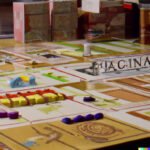Do you remember spending countless hours playing classic board games in the 80s? The nostalgia of games such as Monopoly, Scrabble, and Trivial Pursuit still resonates with many people today. In this article, we will take a trip down memory lane and explore the enduring appeal of classic board games from the 80s.
The 1980s marked a significant rise in the popularity of classic board games. Families and friends would gather around the dining table for game nights, creating lasting memories while engaging in friendly competition. From the simple roll of dice to strategic wordplay, these games became an integral part of social gatherings and entertainment during that era.
In this section, we will delve into the impact these classic board games had on shaping family game nights and discuss why they continue to hold up today. Whether you are a fan of retro gaming or simply curious about the origins of modern board games, join us as we reminisce about the timeless treasures that defined an era.
The Rise of Classic Board Games in the 80s
The 1980s were a golden age for classic board games, marked by the rise in popularity of these timeless favorites. During this decade, classic board games experienced a surge in demand and became a staple in many households across the country. This era saw an explosion of creativity and innovation, with game developers introducing iconic titles that continue to resonate with players today.
Pop Culture Phenomenon
The 80s marked a significant shift in the cultural landscape, and classic board games played a pivotal role in shaping the entertainment industry during this time. From TV shows and movies to commercials and advertisements, these beloved games permeated popular culture, becoming synonymous with family fun and bonding. Whether it was the catchy jingles or memorable catchphrases associated with these games, they captured the hearts of children and adults alike.
Economic Boom
The economic prosperity of the 80s also contributed to the increased popularity of classic board games. With more disposable income at their disposal, families were able to invest in leisure activities such as board games. This financial freedom allowed for an expansion of the gaming market, giving rise to a diverse array of options for consumers to choose from. Board game sales reached unprecedented heights as families flocked to stores to purchase these timeless treasures.
Social Impact
Beyond providing hours of entertainment, classic board games from the 80s had a profound impact on social dynamics within households. These games served as catalysts for building strong familial bonds and fostering meaningful interactions between loved ones. The competitive nature of some games encouraged friendly rivalries, while cooperative gameplay promoted teamwork and collaboration. As a result, classic board games became instrumental in creating cherished memories that continue to be cherished by those who grew up during this remarkable era.
Iconic Classic Board Games From the 80s
The 1980s were a golden era for classic board games, with a surge in popularity that has left a lasting impact to this day. From strategic war games to lighthearted family-friendly fare, the decade produced some of the most iconic board games of all time. These classics continue to hold a special place in the hearts of gamers who came of age during the era, and have even found new life with younger generations.
One of the most beloved classic board games from the 80s is “The Game of Life”, which simulates a person’s journey through life, from college to retirement. Another staple from this era is “Clue”, a murder mystery game that challenges players to use deductive reasoning to solve a crime.
And who can forget “Trivial Pursuit”, the ultimate trivia game that has been entertaining and challenging players for decades. These are just a few examples of the timeless classics that emerged from the 80s board game renaissance.
In addition to their entertainment value, classic board games from the 80s also played an important role in shaping social interactions and family dynamics. These games brought people together around the kitchen or coffee table, providing hours of shared fun and fostering friendly competition. For many families, these board games were an integral part of their bonding rituals, creating cherished memories that have stood the test of time.
| Classic Board Game | Year Released |
|---|---|
| The Game of Life | 1980 |
| Clue | 1985 |
| Trivial Pursuit | 1982 |
How Classic Board Games From the 80s Shaped Family Game Nights
During the 1980s, classic board games became a staple of family game nights, shaping how families spent quality time together. The popularity of these timeless games grew as they offered a break from the fast-paced technological advancements of the era.
Families would gather around the dining table, rolling dice, strategizing, and laughing together while playing these beloved classics. This era witnessed an increase in sales of classic board games as they brought joy and entertainment to households across the country.
Games like Monopoly, Scrabble, and Clue were not only sources of entertainment but also served as tools for bonding and fostering healthy competition among family members. These classic board games encouraged communication, critical thinking, and social skills in individuals of all ages. Whether it was a lazy Sunday afternoon or a special occasion, families would come together to engage in friendly competitions that left lasting memories.
The influence of these classic board games from the 80s is still evident today in how families spend time together. While digital forms of entertainment have become predominant, many families continue to embrace traditional board games as a way to disconnect from screens and connect with one another. The impact of classic board games from the 80s on family game nights is undeniable and remains an integral part of family traditions.
The Enduring Appeal of Classic Board Games From the 80s
When it comes to classic board games from the 80s, there’s something timeless about these beloved titles that continues to captivate players of all ages. Whether it’s the simple yet engaging gameplay, the nostalgia of childhood memories, or the opportunity for face-to-face interaction in a digital age, these games have managed to stand the test of time. Let’s take a look at why classic board games from the 80s still hold up today.
1. Nostalgic Appeal: Classic board games from the 80s evoke a sense of nostalgia for many who grew up playing them. The familiar game pieces, colorful boards, and simple rules transport players back to a simpler time, creating a warm feeling of reminiscence and joy.
2. Timeless Gameplay: Despite the advancements in technology and modern gaming options, classic board games from the 80s offer timeless gameplay that remains enjoyable for both seasoned players and newcomers alike. From strategy-based games like Risk and Axis & Allies to luck-based games like Candy Land and Chutes and Ladders, these classics continue to provide endless hours of entertainment.
3. Social Interaction: In an era dominated by screens and virtual experiences, classic board games from the 80s offer a valuable opportunity for real-life social interaction.
Gathered around a table with friends or family, players can engage in friendly competition, teamwork, and good-natured banter as they strategize and roll the dice. This social aspect is part of what makes these games so enduringly popular – they bring people together in a way that digital entertainment simply cannot replicate.
These factors contribute to the enduring appeal of classic board games from the 80s, ensuring that they will continue to hold a special place in the hearts of fans for years to come.
The Collector’s Edition
The 1980s were a golden era for classic board games, with a surge in popularity that has left a lasting impact on the gaming industry. During this time, iconic games such as Monopoly, Scrabble, and Trivial Pursuit became household names, dominating family game nights and shaping the way we view board games today.
One of the enduring appeals of classic board games from the 80s is the nostalgia they evoke. Many people have fond memories of playing these games with their friends and family during their formative years.
As a result, there is a growing market for vintage versions of classic board games from the 80s, with collectors seeking out original editions to add to their collections. These vintage versions often come in unique packaging and include elements that may have been updated or replaced in newer editions, adding to their allure for collectors.
Moreover, tracking down vintage versions of classic board games from the 80s can be a rewarding experience for enthusiasts. Whether it’s scouring flea markets, attending estate sales, or searching online auction sites, the hunt for these rare finds can be an adventure in itself. For many collectors, acquiring these vintage editions is not just about owning a piece of gaming history but also about reliving cherished memories from their youth.
| Classic Board Game | Vintage Version Pricing (USD) |
|---|---|
| Monopoly | $100 – $500 |
| Scrabble | $50 – $200 |
| Trivial Pursuit | $75 – $300 |
The Evolution of Classic Board Games From the 80s
The 1980s was a pivotal decade for classic board games, as it witnessed the rise of iconic games that continue to hold a special place in the hearts of many. However, the impact of these classic board games from the 80s goes beyond mere nostalgia – they have had a profound influence on modern board games, shaping the way we approach game design and gameplay.
Innovative Game Mechanics and Design
Classic board games from the 80s introduced several innovative game mechanics and design elements that have since become commonplace in modern board games. For example, games like “Risk” and “Axis & Allies” popularized complex strategy gameplay, paving the way for modern strategy board games like “Settlers of Catan” and “Ticket to Ride.” Similarly, the role-playing elements in “Dungeons & Dragons” inspired a new genre of storytelling-driven board games that continue to captivate players today.
Social Interaction and Cooperative Play
Many classic board games from the 80s emphasized social interaction and cooperative play, bringing families and friends together around the gaming table. Games like “Trivial Pursuit” and “Pictionary” encouraged communication, teamwork, and lively discussion, setting a precedent for modern party and trivia games that prioritize group dynamics and shared experiences.
Thematic Immersion and Narrative
Another enduring legacy of classic board games from the 80s is their emphasis on thematic immersion and narrative. Games like “Clue” and “Mystery Date” immersed players in compelling stories with rich settings and characters, laying the groundwork for modern narrative-driven board games such as “Betrayal at House on the Hill” and “Dead of Winter.” The imaginative worlds created by these classic games continue to inspire contemporary game designers to craft immersive experiences that transport players to captivating fictional universes.
The influence of classic board games from the 80s on modern board games is undeniable, as they continue to shape the industry with their innovative mechanics, emphasis on social interaction, thematic immersion, and enduring appeal. As we cherish our fond memories of playing these timeless classics, we can also appreciate their lasting impact on the evolution of board gaming as a whole.
The Legacy of Classic Board Games From the 80s
As we look back at the legacy of classic board games from the 80s, it’s clear that these games have left a lasting impact on both the gaming industry and family traditions. The nostalgia surrounding these iconic games continues to shape how families come together for game nights and how new generations are introduced to the joys of analog entertainment.
The enduring appeal of classic board games from the 80s lies in their ability to bring people together. Whether it’s playing a game of Monopoly, Scrabble, or Clue, these timeless classics have proven their ability to transcend generations and provide hours of fun and entertainment. Despite the advancements in technology and the rise of digital gaming, there is still something special about gathering around a table to roll dice, move pieces, and engage in friendly competition.
In an age where technology often takes center stage, there is something comforting about passing down the tradition of classic board games from the 80s to a new generation. By introducing children to these beloved games, we not only share a piece of our own childhood but also instill valuable skills such as critical thinking, strategy, and social interaction.
As we continue to cherish the memories associated with these timeless classics, it’s clear that they will remain a cherished part of family traditions for years to come.
Frequently Asked Questions
What Board Game Was Popular in the 80s?
In the 1980s, the board game Trivial Pursuit became hugely popular. It was a trivia game that tested players’ knowledge in various categories, and it quickly became a staple at social gatherings and family game nights.
What Was a Popular Board Game in the 70’s?
One of the most popular board games in the 1970s was “The Game of Life.” This classic game simulated various life events such as education, career, marriage, and retirement, allowing players to experience different paths and outcomes.
What Was the Most Popular Board Game in 1985?
The most popular board game in 1985 was undoubtedly “Monopoly.” This timeless classic has been a favorite for decades, allowing players to buy, sell, and trade properties while trying to bankrupt their opponents. Its enduring popularity has made it a household name in board games.

I love playing all kinds of games – from classics like Monopoly to modern favourites like Ticket to Ride.
I created this blog as a way to share my love of board games with others, and provide information on the latest releases and news in the industry.





